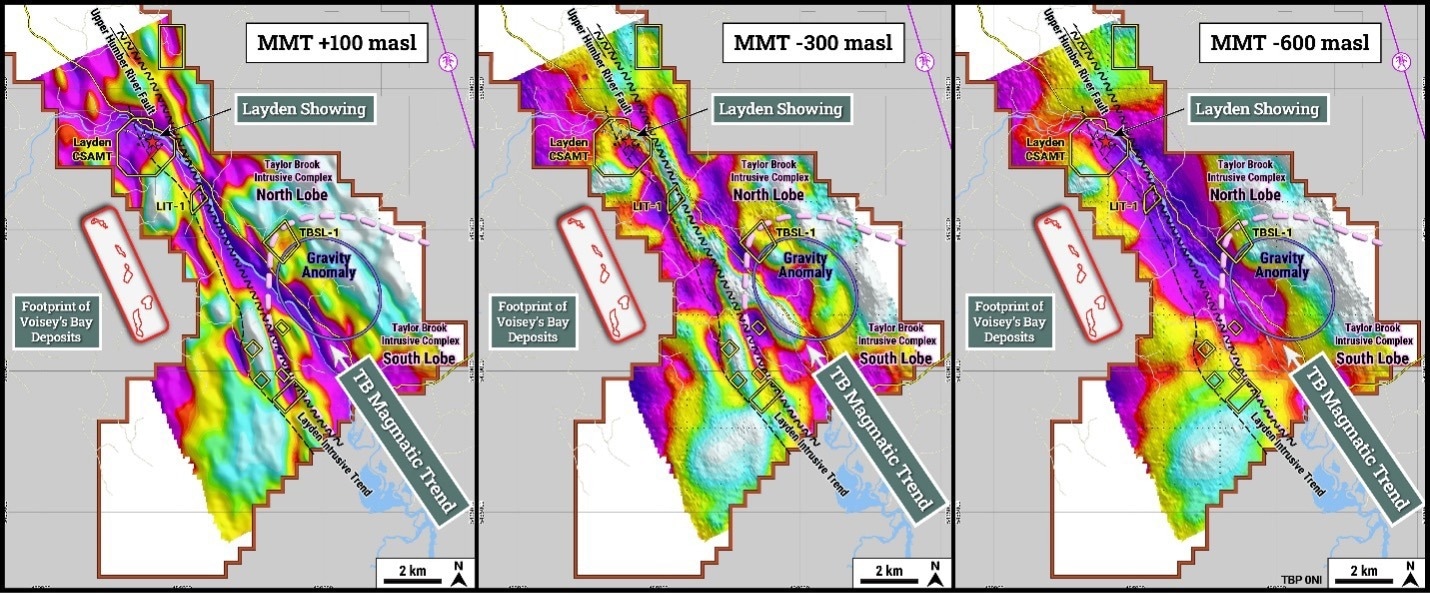Reviewed by Lexie CornerMar 1 2024
According to Churchill Resources Inc., this winter's drilling and geophysical investigations revealed the existence of a new, significant, active magmatic intrusive system that stretches 13 km southeast of the Layden Nickel Showing region to the south lobe of the Taylor Brook Gabbro Complex. Specifically:
 MMTResistivity Level Plans Show TB Magmatic Trend Widening at Depth. Image Credit: Churchill Resources
MMTResistivity Level Plans Show TB Magmatic Trend Widening at Depth. Image Credit: Churchill Resources
- The 13 km TB Magmatic Trend is confirmed by CRI’s 2023 exploration using geophysics, soils, and diamond drilling
- The TB Magmatic Trend spans from Layden Nickel Showing to the TBGC South Lobe
- The TBGC South Lobe is of priority interest owing to its severe gravity anomaly on the rifted continental edge, a type locale where nickel districts are frequently located
- At Layden, drilling has effectively reached sulfide-bearing breccias and gabbroic intrusive rocks in every hole
- It is proven that resistivity surveys have successfully mapped parts of the magmatic intrusive system
- In 2024, conductivity surveys will be used to cover the 13 km TB Magmatic Trend to find vast and dispersed sulfide targets
Churchill’s exploration team has had a successful year at Taylor Brook, and we’re incredibly excited by the definitive identification of the TB Magmatic Trend and understanding its relationship to the Layden high-grade nickel as well as the rifted continental margin. Paul Sobie and his team have already shown there is a definitive age and rock-type relationship between Layden and the South Lobe of the TBGC, and this trend or conduit has now been clearly mapped by our geophysical surveys.
Bill Fisher, Chairman, Churchill Resources
He added, “2024 should be a big year for the project–we already have compelling drill targets at the LIT-1 and TBSL-1 nickel soil anomalies, and comprehensive follow-up along the trend should result in many more.”
In contrast to the extremely resistant older gneissic country rock, the recently discovered TB Magmatic Trend is characterized by low to very low resistivity responses in aerial Mobile Magnetotelluric (MMT) and ground Controlled Source Audio Magnetotelluric (CSAMT) studies.
Examinations of sectional and level plan resistivity data reveal a continuous vertically oriented dyke-like conduit that flares into sill-like bodies at specific depths, including at Layden in the far north. Due to nearby power lines interfering with the lower frequency response, the MMT survey’s depth penetration was restricted to around 600 m.
Drilling at Layden
This winter, eight 4,573-m holes were drilled, all focused on CSAMT resistivity low features. All the holes intersected large areas of sulfidic breccias with anomalous Ni, Cu, and Co values similar to those found at the Layden Breccia, as well as thick intervals of gabbronorite intrusive rocks. The results for holes TB24-38 to -40, which also encountered mineralization resembling breccia, are still pending.
Following the completion of borehole electromagnetic investigations, off-hole conductors were found in holes TB23-06E, -35, -37, and TB24-39-40. To help with the potential detection of high-grade sulfides, as observed at Layden, Maxwell Plate modeling of these conductors is now underway.
The Layden Showing with elevated mineralization and surrounding wide areas of breccia stringer mineralization seems to be a sill-like structure that was counteracted by subsequent faulting from the main TB Magmatic Trend. It highlights the similarities in architecture and brecciation zones at Layden between the CRI drill section and the magmatic nickel exploration model.
According to all available data, Layden Showing is a faulted offset sill-like body located off the northernmost point of the TB trend, which was once thought to be associated with the TB Magmatic Intrusive Trend.
The company is now organizing a comprehensive exploration program for 2024 that will focus on the TB Magmatic Trend using borehole electromagnetic surveys, diamond drilling, and ground geophysical surveys (CSAMT, Induced Polarization, and Time Domain Electromagnetic).
Planning is also underway for the Florence Lake nickel project in Labrador, where the company has found a very large ultramafic intrusive target with tremendous low-grade tonnage potential, as well as 43 possible Raglan-like komatiitic nickel prospects.